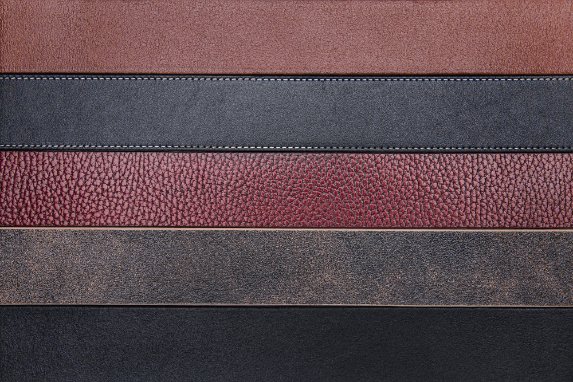Leather and suede items add luxury to any wardrobe, but they need special care to stay beautiful and last for years. The key to preserving leather and suede is regular cleaning with the right products and techniques, like brushing suede with a soft-bristled brush and treating leather with proper conditioners.
When it comes to suede specifically, quick action on stains makes all the difference. Apply a suede protector spray to prevent water damage and stains. For cleaning, gentle hand washing with mild detergent in cool water works for some items, but never wring out wet suede as this damages the material.
Table of Contents
Key Takeaways
- Regular maintenance with appropriate brushes and cleaners extends the life of leather and suede garments
- Address stains immediately and use protective sprays to prevent water and dirt damage
- Proper storage and seasonal care prevent creasing, fading and unwanted texture changes in leather and suede items
- Follow specific conditioning schedules based on usage, climate, and leather type
- Know when to use professional services versus DIY care methods
Understanding Leather and Suede
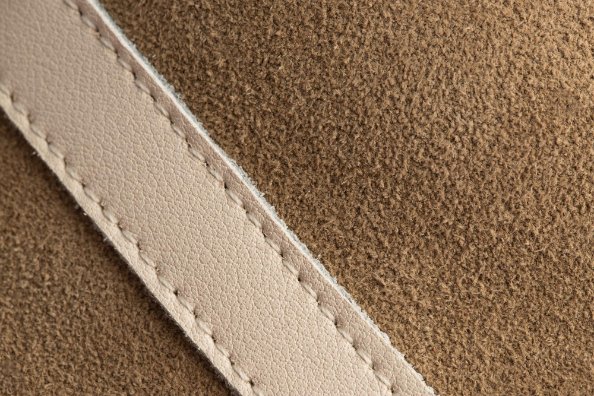
Leather and suede are popular materials for clothing and accessories because of their durability and luxurious appearance. These natural materials require specific care to maintain their quality and extend their lifespan.
Characteristics of Leather
Leather is animal skin that has been treated through a process called tanning to prevent decay. It’s known for its durability, flexibility, and ability to breathe, allowing air to circulate through the material.
Most leather comes from cattle hides, though sheep, goat, and pig skins are also common. Good-quality leather develops a unique patina over time, which enhances its appearance rather than deteriorating it.
Leather has natural water resistance, though it isn’t completely waterproof. When properly maintained, leather items can last for decades. The material molds to your body over time, creating a custom fit in jackets, shoes, and gloves.
Regular conditioning keeps leather supple and prevents cracking. Without proper care, leather can dry out, stiffen, and eventually crack.
Types of Leather: Full-Grain to Nubuck
- Full-grain leather is the highest quality, using the entire thickness of the hide with the natural grain intact. It’s the most durable but also the most expensive.
- Top-grain leather has the surface sanded to remove imperfections. It’s thinner and more pliable than full-grain but still quite durable.
- Genuine leather is made from the lower layers of the hide. It’s less expensive but won’t last as long as higher grades.
- Bonded leather consists of leather scraps bonded together with adhesives. It’s the least durable type.
- Nubuck leather is top-grain leather that’s been sanded or buffed on the grain side to create a velvet-like surface. It has a soft texture similar to suede but is more durable.
Understanding Suede Leather
Suede is created from the underside of animal skin, giving it a distinctive napped finish. This material is recognized by its soft, fuzzy texture and is typically made from lamb, goat, calf, or deer hides.
Unlike regular leather, suede lacks the exterior skin layer, making it more porous and susceptible to water damage and staining. Apply a protective spray specifically designed for suede to create a barrier against moisture and dirt.
The delicate nap of suede requires special care tools, including a suede brush to raise the nap and remove dirt. Suede erasers can effectively lift stains without damaging the material.
Suede offers excellent flexibility and comfort, making it ideal for shoes, jackets, and gloves. However, its softness means it wears down more quickly than smooth leather in high-friction areas.
Basic Care Guidelines
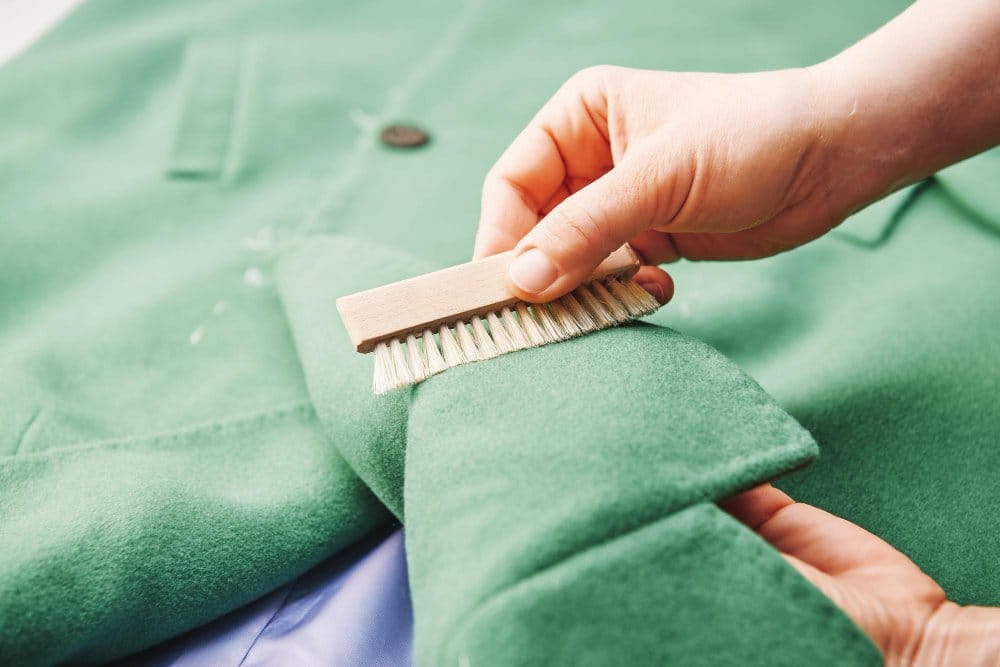
Taking care of leather and suede items requires some simple but consistent practices. Proper maintenance will significantly extend the life of your favorite pieces and keep them looking their best.
General Handling and Storage
Always hang leather jackets and coats on padded hangers to maintain their shape. Store suede items in breathable garment bags, never in plastic which can trap moisture and cause mildew.
Keep leather and suede away from direct sunlight, which can cause fading and drying. When not wearing your items, store them in a cool, dry place with good air circulation.
Never store leather or suede clothing when wet. Allow items to dry naturally at room temperature, away from direct heat sources like radiators or hair dryers which can cause cracking and warping.
Avoid overcrowding your closet. Leather and suede need space to “breathe” and prevent unnecessary creasing or shape distortion.
Protecting Your Items
Apply a quality protector spray specifically formulated for leather or suede before first wear. Spray from about an arm’s length away to ensure even coverage without oversaturation.
For suede items, invest in a soft-bristled brush to remove dust and maintain the nap. Brush gently in one direction to preserve the material’s texture and appearance.
Treat spills immediately by blotting (never rubbing) with a clean, dry cloth. For leather, use specialized leather cleaners for spot treatment.
Use water and stain repellent sprays seasonally – typically every 3-4 months for frequently worn items. These create an invisible barrier against everyday elements.
Consider professional cleaning once a year for valuable leather and suede pieces, especially jackets or coats that see regular use.
Visual reference for implementing these essential care practices in your routine:

Following these fundamental guidelines prevents 90% of common leather and suede damage, saving you costly professional restoration later.
Cleaning Techniques
Proper cleaning helps maintain the beauty and extend the life of your suede garments. Different situations call for different approaches, from regular maintenance to addressing unexpected spills.
Routine Cleaning Tips
Invest in a suede brush with two sides – one with wire bristles for removing dried mud and the other softer side for regular brushing. This tool is essential for maintaining suede.
Brush your suede garments after each wear to remove dust and prevent dirt buildup. Always brush in one direction to avoid damaging the nap.
For light cleaning, gently wipe the surface with a clean, damp microfiber cloth. This can remove minor spotting and surface dirt without saturating the material.
Never store suede in plastic bags. Instead, use cloth garment bags that allow the material to breathe when not in use. Keep suede items in a cool, ventilated space to prevent mildew and odors.
Removing Stains and Spills
When facing a spill, act quickly but carefully. Blot liquid spills immediately with a clean, dry cloth. Don’t rub, as this can push the stain deeper into the fibers.
For dried stains, lightly brush with the wire side of your suede brush to loosen particles before cleaning.
Water spots can be addressed by lightly dampening the entire area and gently brushing once dry. This helps even out the appearance of the material.
For stubborn stains, use specialized suede cleaners. Apply these products according to their instructions, typically from 6-8 inches away to avoid oversaturation.
Important: For valuable or delicate suede items, professional cleaning is often the safest option. Home remedies might damage the material permanently.
Follow this systematic approach to tackle any cleaning challenge:

Remember, the key to successful cleaning is patience and using the right technique for each specific stain type.
Visual Guide to Suede Jacket Cleaning
While written instructions provide the foundation for proper suede care, seeing the techniques in action can make all the difference between success and costly mistakes. This detailed video demonstration walks you through the complete process of cleaning a suede jacket safely and effectively.
Watch this step-by-step tutorial to see professional suede cleaning techniques in action:
Key points from the demonstration:
- Always test cleaning products in an inconspicuous area first
- Work in small sections to maintain control over the cleaning process
- Allow complete drying between cleaning steps
- Use proper brushing techniques to restore the suede’s natural nap
Remember, while these techniques work for most suede jackets, extremely valuable or vintage pieces should always be handled by professional leather care specialists. When in doubt, consult an expert rather than risk permanent damage to irreplaceable items.
Does Water Ruin Suede Leather?
Water can seriously damage suede, but it doesn’t always ruin it completely. When suede gets wet, the water bonds with the natural oils in the leather and can cause permanent staining, stiffness, and color changes. The fibers may also become matted and lose their soft texture.
Light rain or minor water exposure won’t destroy suede, but prolonged moisture exposure will cause lasting damage. If your suede gets wet, immediate action can often save it.
What Happens if a Suede Jacket Gets Wet?
When a suede jacket gets wet, several things can happen:
- The color may darken temporarily or permanently
- Water marks and stains may appear
- The nap may become matted and lose its soft texture
- The jacket may become stiff and uncomfortable
- Mold or mildew may develop if not dried properly
The good news is that many water-damaged suede items can be restored with proper care techniques.
How to Restore Suede After It Gets Wet
If your suede gets wet, follow these steps immediately:
- Blot excess water with a clean, absorbent cloth – don’t rub
- Stuff with newspaper to maintain shape and absorb moisture
- Air dry completely away from heat sources and direct sunlight
- Steam gently by holding the item over boiling water briefly
- Brush thoroughly with a suede brush once completely dry
- Apply suede protector once the item is restored
For severe water damage, professional restoration may be necessary.
Professional Care and Services
While proper home care extends the life of leather and suede garments, some situations require expert attention. Professional services offer specialized treatments that can restore damaged items and provide thorough cleaning beyond what’s possible at home.
When to Seek Professional Cleaning
Take leather and suede items to professionals when they have stubborn stains, significant dirt buildup, or water damage. Most experts suggest professional cleaning every 12-18 months for regularly worn items, even without visible soiling.
Professionals should handle vintage or expensive pieces, as DIY cleaning might cause irreparable damage. If your leather has started to look dull or lost its natural oils, it’s time for expert care.
Many services like Tide Cleaners and LeatherCareUSA specialize in leather and suede. Some even offer free delivery for added convenience, making professional maintenance hassle-free.
Understanding the Cleaning Process
Professional leather cleaning involves several specialized steps. The process typically begins with an assessment of the garment’s condition and identifying the type of leather or suede.
Experts use specialized cleaning solutions designed for specific leather types. Unlike home cleaning, professionals can safely remove embedded dirt without damaging the material.
The typical service time runs about 12-14 business days for standard cleaning, according to LeatherCareUSA. More complex jobs including alterations may take 14-20 business days.
Many cleaners like Battiston’s employ technicians with 30+ years of experience specifically in leather care. These specialists use a TLC (tender loving care) process that thoroughly cleans while maintaining the material’s integrity and appearance.
Use this decision framework to determine the best care approach for your situation:

Investing in professional care for valuable items often costs less than replacing damaged pieces.
Can You Dry Clean Leather and Suede?
Yes, but with important caveats. Professional dry cleaning can be effective for leather and suede, but only when performed by specialists experienced with these materials. Regular dry cleaners may not have the expertise needed for proper leather care.
Dry cleaning works well for:
- Removing embedded odors
- Deep cleaning without water damage
- Treating delicate vintage pieces
- Restoring severely soiled items
Always verify that the dry cleaner has specific experience with leather and suede before entrusting valuable items to their care.
DIY Maintenance and Advanced Care
Taking care of your leather and suede at home can save you money and extend the life of your favorite items. With a few simple tools and techniques, you can handle most routine maintenance without professional help.
Home Remedies for Suede Care
Keeping suede looking fresh is easier than you might think. For basic cleaning, invest in a suede brush with stiff bristles. Brush gently in one direction to remove surface dirt and restore the nap.
For small stains, try a suede eraser (or a regular pencil eraser in a pinch). Rub it gently over marks and then brush away the residue.
For tougher spots, steam can work wonders. Hold the suede item over a kettle of boiling water briefly, then brush while the material is still warm.
White vinegar lightly applied with a cloth can tackle salt stains. Once the area dries, brush to restore texture.
Always finish by applying a suede protector spray to guard against future stains and water damage.
Equip yourself with the right tools and master these proven DIY techniques:
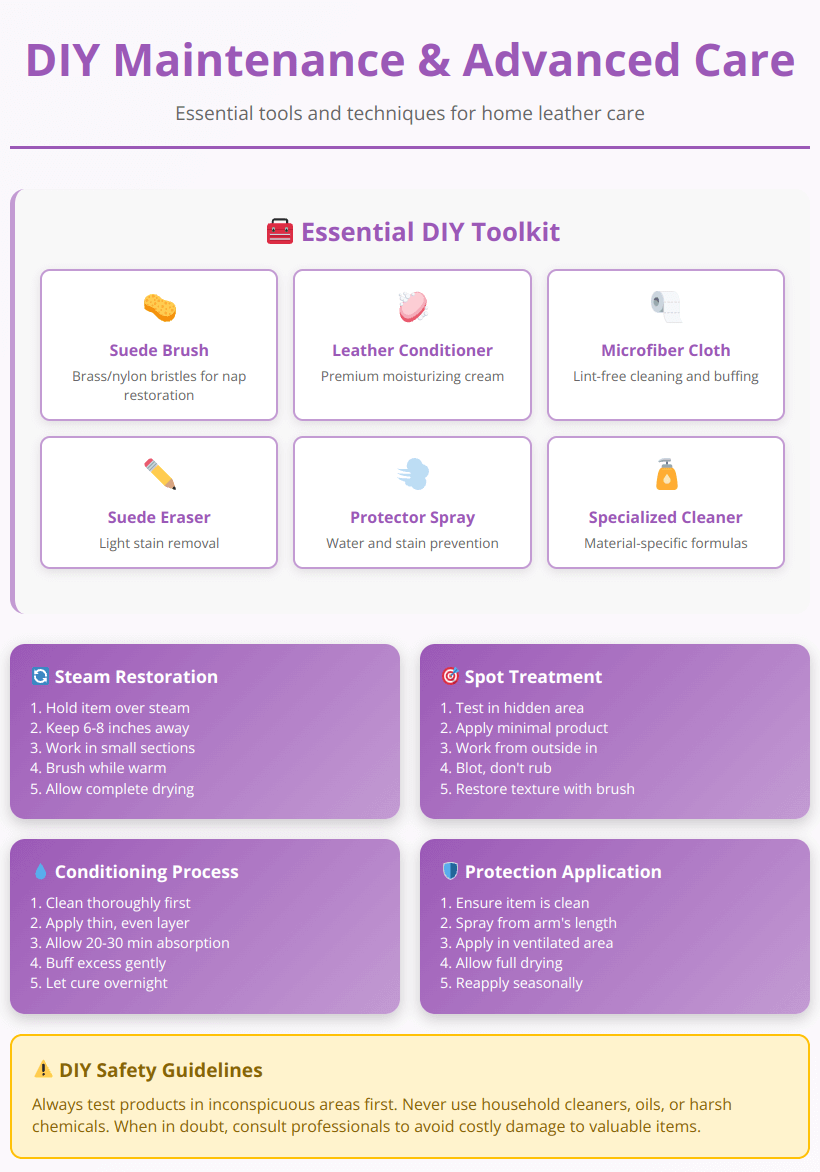
With the proper toolkit and techniques, you can handle most routine maintenance and minor restoration tasks at home.
Master Stain Removal Techniques for Suede
Different types of stains require different approaches, and knowing which method to use can save your suede from permanent damage. From grease spots to water marks, each stain presents unique challenges that demand specific solutions.
This comprehensive video covers multiple stain removal methods for various types of marks and spills:
Essential stain removal reminders:
- Act quickly – fresh stains are always easier to remove than set-in ones
- Always work from the outside of the stain toward the center to prevent spreading
- Never rub or scrub aggressively, as this can damage the suede’s delicate nap
- Multiple light treatments are better than one aggressive attempt
- Different stain types (oil, water, ink, food) require different approaches
The techniques shown in this video work for most common stains, but remember that expensive or sentimental suede items warrant professional treatment. Some stains, particularly those involving permanent dyes or certain chemicals, may require specialized restoration services that only professionals can provide safely.
Do Pencil Erasers Work on Suede?
Yes, pencil erasers can be surprisingly effective on suede stains. Use a clean, white eraser to gently rub away surface marks and light stains. The eraser removes the damaged fibers and reveals fresh suede underneath.
This technique works best on:
- Light scuff marks
- Surface stains
- Pencil marks
- Light oil spots
Always brush the area with a suede brush after using an eraser to restore the nap.
How to Stop a Suede Jacket from Shedding
New suede jackets often shed initially. To minimize shedding:
- Brush regularly with a soft suede brush to remove loose fibers
- Use a lint roller to pick up excess fibers
- Avoid over-brushing which can damage the nap
- Store properly in a breathable garment bag
- Professional treatment can stabilize the fibers if shedding persists
Quality suede should stop shedding after a few wears with proper care.
How to Soften a Stiff Suede Leather Jacket
If your suede jacket becomes stiff, try these methods:
- Steam treatment – Hold over boiling water briefly
- Gentle stretching – Carefully flex the jacket while warm
- Professional conditioning – Use suede-specific conditioners
- Brush thoroughly – Work the nap to restore flexibility
- Wear regularly – Movement helps maintain suppleness
Never use regular leather conditioner on suede, as it will ruin the texture.
How to Get Wrinkles Out of Suede
Removing wrinkles from suede requires gentle methods:
- Hang properly on padded hangers to let gravity work
- Steam carefully by hanging in a steamy bathroom
- Use a garment steamer on the lowest setting
- Brush while warm to restore the nap
- Professional pressing for stubborn wrinkles
Never use a traditional iron on suede, as the heat and pressure will flatten the nap permanently.
Leather Conditioning and Polishing
Regular conditioning prevents leather from drying out and cracking. Start by wiping leather with a slightly damp cloth to remove dust and dirt.
For conditioning, apply a small amount of leather conditioner with a soft cloth using circular motions. Less is more here – a thin, even layer works best. Allow it to absorb for 20-30 minutes.
Buff with a clean cloth to remove excess product and create a subtle shine. For extra protection, follow with a leather protector spray.
To restore color to faded areas, leather polish or cream in a matching shade works well. Test in an inconspicuous spot first.
Minor scratches often respond to a tiny amount of olive oil or petroleum jelly rubbed in gently, then buffed clean.
What to Moisturize Leather With?
The best leather moisturizers include:
Commercial leather conditioners:
- Saphir Médaille d’Or conditioners
- Leather Honey conditioner
- Chamberlain’s Leather Milk
- Bickmore Bick 4
Natural alternatives:
- Neatsfoot oil (for heavy-duty leather)
- Mink oil (for waterproofing)
- Beeswax-based conditioners
- Lanolin-based products
Avoid these common mistakes:
- Vaseline (petroleum jelly) – can clog pores and attract dirt
- Baby oil – too light and may cause staining
- Olive oil – can go rancid and darken leather
- WD-40 – designed for metal, not leather
Is Beeswax Good for Leather?
Yes, beeswax is excellent for leather care. It provides:
- Natural waterproofing without clogging pores
- Flexibility preservation while adding protection
- Long-lasting conditioning that penetrates deeply
- Natural antibacterial properties that prevent deterioration
Beeswax works particularly well for work boots, outdoor gear, and vintage leather items. Apply sparingly and buff well for best results.
How to Moisturize Dried Out Leather
For severely dried leather:
- Clean thoroughly with a leather cleaner
- Apply conditioner slowly in thin layers
- Allow full absorption between applications
- Repeat the process 2-3 times over several days
- Maintain regularly to prevent future drying
Severely damaged leather may require professional restoration for best results.
Conditioning Schedule and Frequency Guide
Understanding when and how often to condition your leather and suede is crucial for maintaining their longevity and appearance.
According to leather care experts at Leather Honey, one of the industry’s leading authorities since 1968, the frequency of conditioning depends on both leather type and climate conditions. They recommend conditioning twice yearly as a baseline, but items exposed to frequent sunlight may need conditioning three to four times annually.
How Often Should You Condition Leather?
The conditioning frequency depends on several factors:
Usage-based schedule:
- Daily wear items: Every 3-4 months
- Weekly wear items: Every 6 months
- Seasonal items: Twice yearly (spring/fall)
- Occasional wear: Once yearly
Climate considerations:
- Hot, dry climates: More frequent conditioning needed
- Humid climates: Less frequent conditioning required
- Indoor heating/cooling: May require additional conditioning
Leather type factors:
- Vegetable-tanned leather: More frequent conditioning
- Chrome-tanned leather: Less frequent conditioning
- Pull-up leather: As the protective layer depletes
- Finished leather: May need less conditioning
Conditioning Schedule Chart
| Item Type | Usage Level | Conditioning Frequency |
|---|---|---|
| Work boots | Daily | Every 2-3 months |
| Dress shoes | Weekly | Every 6 months |
| Leather jacket | Seasonal | Twice yearly |
| Handbag | Daily | Every 3-4 months |
| Belt | Daily | Every 4-6 months |
| Furniture | Household use | Twice yearly |
Use this comprehensive schedule to maintain optimal conditioning for all your leather items:
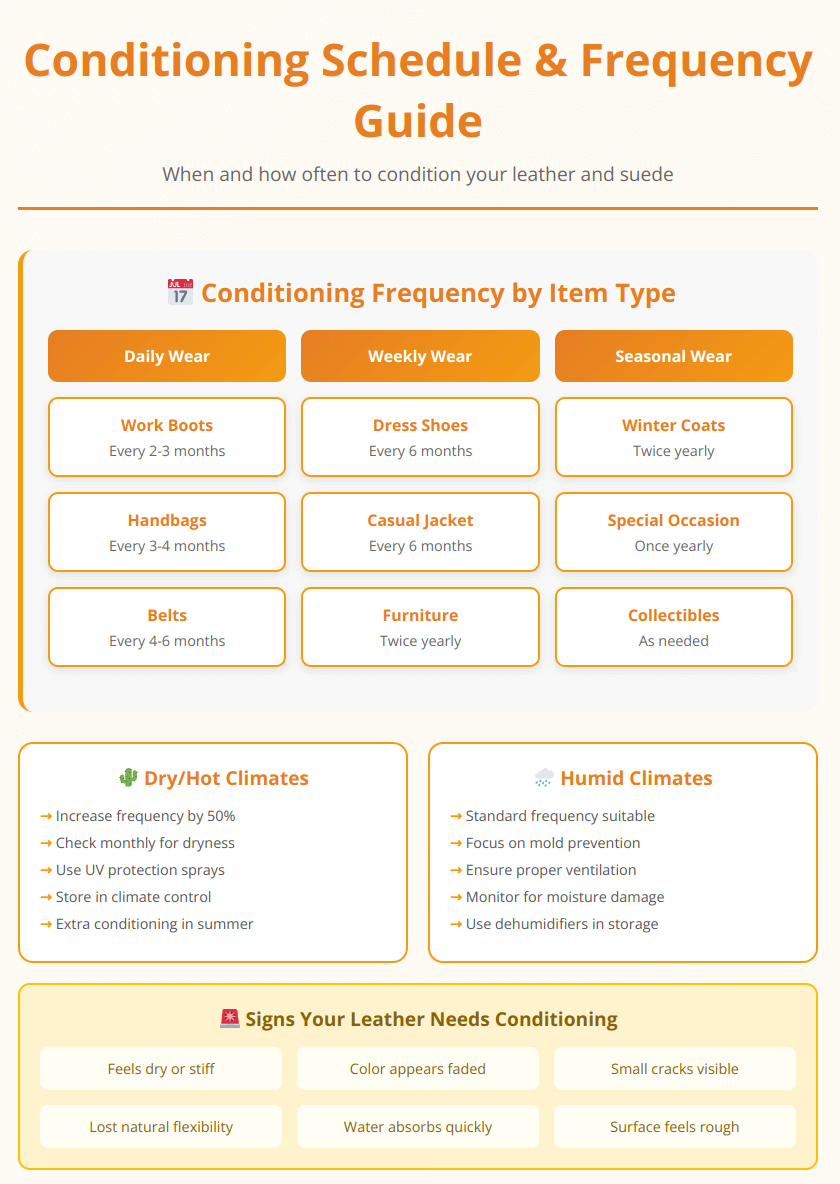
Consistent conditioning based on these guidelines will keep your leather supple and prevent premature aging.
Want a personalized care schedule for your specific items and climate? Use our Care Schedule Calculator to get customized timing recommendations based on professional guidelines.
Signs Your Leather Needs Conditioning
Watch for these indicators:
- Leather feels dry or stiff
- Color appears faded or dull
- Small cracks beginning to appear
- Loss of natural flexibility
- Water absorption has decreased
Best Products and Tool Recommendations
Top Leather Conditioners by Category
Premium conditioners:
- Saphir Médaille d’Or Renovator – €15-20
- Leather Honey conditioner – $12-15
- Chamberlain’s Leather Milk No. 1 – $16-20
Budget-friendly options:
- Bickmore Bick 4 – $8-12
- Kiwi Saddle Soap – $6-10
- Meltonian Cream – $10-15
Specialty products:
- Obenauf’s Heavy Duty LP – Work boots
- Sno-Seal Beeswax – Winter protection
- Pecards Classic – Vintage leather
Essential Tools for Leather and Suede Care
Basic kit should include:
- Suede brush (brass/nylon bristles)
- Soft cloth (microfiber preferred)
- Leather cleaner
- Appropriate conditioner
- Protective spray
- Suede eraser
Advanced tools:
- Horsehair brush set
- Chamois cloth
- Steam brush
- Professional leather dyes
- Edge dressing applicators
What is the Best Suede Protector?
Top suede protectors include:
Premium options:
- Saphir Super Invulner – Excellent water resistance
- Crep Protect – Superior stain protection
- Jason Markk Repel – Eco-friendly formula
Budget choices:
- Kiwi Protect All – Basic protection
- Scotchgard Heavy Duty – Widely available
- Nikwax Nubuck & Suede Proof – Outdoor gear focus
Apply protectors in well-ventilated areas and allow full drying before wear.
What is the Best Brush for Suede Jacket?
For suede jackets, choose brushes with:
- Brass bristles – For removing tough stains and restoring matted nap
- Nylon bristles – For regular maintenance and gentle cleaning
- Crepe rubber – For lifting surface dirt and light stains
Recommended brands:
- Saphir Gommadin brush set
- Kiwi suede brush
- Angelus suede cleaning kit
Choose the right products and tools for your specific needs and budget:

Investing in quality products suited to your leather type ensures better results and prevents damage from incompatible formulations.
Seasonal and Long-Term Care
Your leather and suede items need different care depending on the time of year. Weather conditions affect these natural materials in specific ways, requiring you to adjust your maintenance routine seasonally.
Winter Protection
Winter brings moisture and salt that can damage suede and leather. Apply a high-quality suede protector spray before the first snowfall to create a protective barrier. This helps repel water and prevents staining from slush and salt.
For leather items, use a waterproofing cream or spray specifically formulated for leather. Apply it every 3-4 weeks during winter months.
Keep suede items away from heavy snow or rain. If your suede gets wet, let it dry naturally at room temperature—never use direct heat from radiators or hair dryers as this can cause cracking and damage.
Stuff boots and shoes with newspaper when not in use to maintain their shape and absorb excess moisture.
Can You Wear Suede Leather in the Rain?
Generally, no. Suede should be avoided in rainy conditions because:
- Water causes permanent staining and discoloration
- The nap becomes matted and loses its texture
- Drying can leave permanent water marks
- Prolonged moisture exposure can cause cracking
However, treated suede with high-quality protector sprays can withstand light moisture. Never wear untreated suede in rain.
Does Suede Get Ruined in Light Rain?
Light rain may not completely ruin suede, but it can cause damage:
- Temporary darkening that may become permanent
- Water spots that are difficult to remove
- Texture changes in the affected areas
- Potential for mold if not dried properly
If caught in light rain, act quickly to minimize damage by following proper drying techniques.
Summer Maintenance
Summer heat and humidity present different challenges for leather and suede care. Store these items in cool, dry places away from direct sunlight to prevent fading and drying out.
Clean your items more frequently during summer as sweat and oils can transfer easily. Use a suede brush regularly to remove dirt and maintain the nap of suede items.
For leather, apply a lightweight conditioner to prevent it from drying out in air-conditioned environments. This keeps the material supple and prevents cracking.
After wearing, let items air out completely before storing them. This prevents odor buildup and mildew formation in humid conditions.
Long-Term Preservation Strategies
For extended storage, use breathable cotton garment bags rather than plastic covers. Plastic traps moisture and can lead to mildew growth.
Storage checklist:
- Clean thoroughly before storage
- Apply appropriate conditioner or protectant
- Use cedar blocks or acid-free tissue paper to maintain shape
- Store in a cool, dry closet away from direct light
- Check items periodically for signs of damage
Invest in proper maintenance tools: a suede brush, suede eraser for stains, and quality leather conditioner will extend the life of your items considerably.
For valuable pieces, consider professional cleaning annually to address deep-set stains and condition the material properly.
Follow this comprehensive seasonal care strategy to maximize your leather’s lifespan:

Consistent seasonal care and proper long-term storage can extend leather lifespan by 300-500% compared to neglected items.
Stay organized with your leather care routine using our Visual Care Checklist. Track your maintenance tasks and never miss important care steps again.
Never forget seasonal care again! Set up our Seasonal Reminder System to get automated notifications for conditioning, cleaning, and protection based on your local climate and leather items.
How Long Does Suede Leather Last?
With proper care, suede can last:
- High-quality suede: 10-20 years or more
- Medium-quality suede: 5-10 years
- Budget suede: 2-5 years
Factors affecting longevity:
- Quality of original tanning
- Frequency of wear
- Care routine followed
- Environmental exposure
- Professional maintenance
Should You Hang or Fold Suede Jacket?
Always hang suede jackets on padded hangers. Folding can cause:
- Permanent creases
- Compression damage to the nap
- Shape distortion
- Texture flattening
Use wide, padded hangers to distribute weight evenly and maintain the jacket’s shape.
Troubleshooting Common Issues
What Not to Do with Suede
Avoid these common mistakes:
- Never use water for cleaning unless specifically recommended
- Don’t use leather conditioner – it will ruin the texture
- Avoid direct heat for drying
- Don’t use harsh chemicals or household cleaners
- Never put in washing machine or dryer
- Don’t ignore stains – treat immediately
- Avoid wearing in wet weather without protection
Can Suede Go in the Washing Machine?
Absolutely not. Machine washing will:
- Destroy the delicate nap texture
- Cause severe shrinkage
- Create permanent water damage
- Ruin the shape and structure
- Void any warranties
Always use hand cleaning methods or professional services for suede.
How to Protect Suede from Peeling
Prevent suede peeling by:
- Regular brushing to maintain nap health
- Immediate stain treatment to prevent damage
- Proper conditioning with suede-specific products
- Professional maintenance when needed
- Quality storage in breathable containers
Once peeling starts, professional restoration is usually required.
Use this quick-reference guide to address common leather and suede emergencies:

Quick action using the right techniques can save most leather items from permanent damage, but when in doubt, consult professionals immediately.
Emergency Stain Removal Guide
For oil stains:
- Blot immediately with absorbent cloth
- Sprinkle cornstarch or talcum powder
- Let sit overnight to absorb oil
- Brush away powder gently
- Use suede cleaner if stain persists
For food stains:
- Remove excess material carefully
- Allow to dry completely
- Brush gently to remove residue
- Use appropriate cleaning method
- Restore nap with brushing
For ink stains:
- Act immediately – don’t let it set
- Blot gently without spreading
- Use specialized ink remover for suede
- Professional treatment for valuable items
- Never use water on ink stains
Leather Care Deep Dive

How to Wash a Suede and Leather Jacket
For suede portions:
- Never submerge in water
- Spot clean with suede cleaner only
- Use dry cleaning methods
- Professional cleaning recommended
For leather portions:
- Wipe with barely damp cloth
- Use leather cleaner for spot treatment
- Condition after cleaning
- Air dry completely
Combined care:
- Test any product in hidden area first
- Use products appropriate for each material
- Consider professional cleaning for mixed materials
- Never use one-size-fits-all cleaners
What is the Best Leather Cleaner and Conditioner?
Top all-in-one products:
- Saphir Médaille d’Or Omnidaim – Premium choice
- Leather Honey Complete Kit – Great value
- Chamberlain’s Ensemble Set – Professional grade
Separate cleaner and conditioner sets:
- Cleaner: Saphir Reno’Mat + Conditioner: Saphir Renovator
- Cleaner: Lexol Cleaner + Conditioner: Lexol Conditioner
- Cleaner: Bickmore Bick 1 + Conditioner: Bickmore Bick 4
Choose based on your leather type, budget, and maintenance preferences.
Master these advanced techniques and scientific principles for professional-level results:
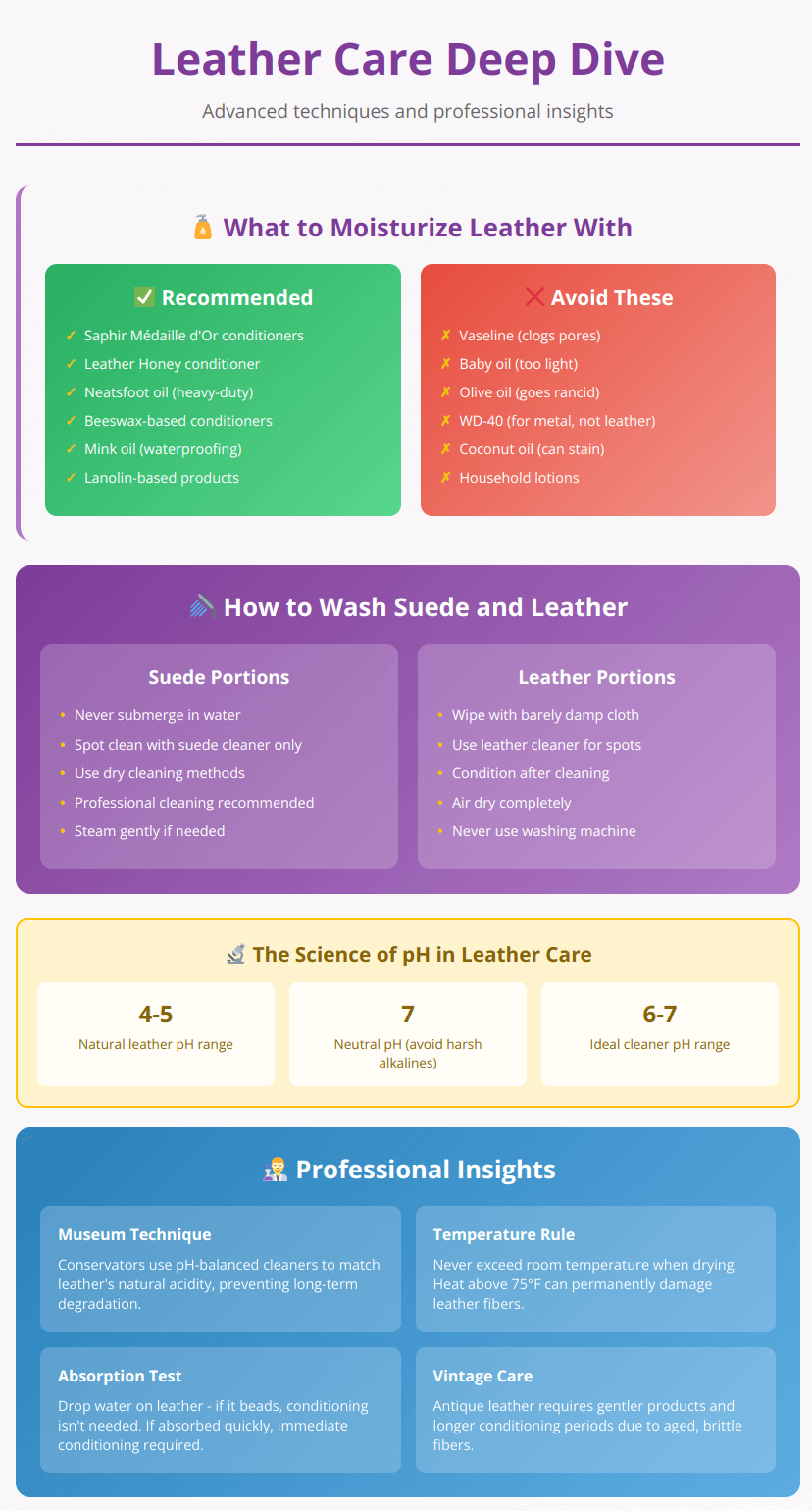
Understanding the science behind leather care enables you to make informed decisions and avoid costly mistakes that damage expensive items.
Not sure which products are right for you? Take our Product Recommendation Quiz to get expert-matched products based on your specific needs, budget, and experience level.
Advanced Restoration Techniques
Understand professional restoration processes and when they’re worth the investment:
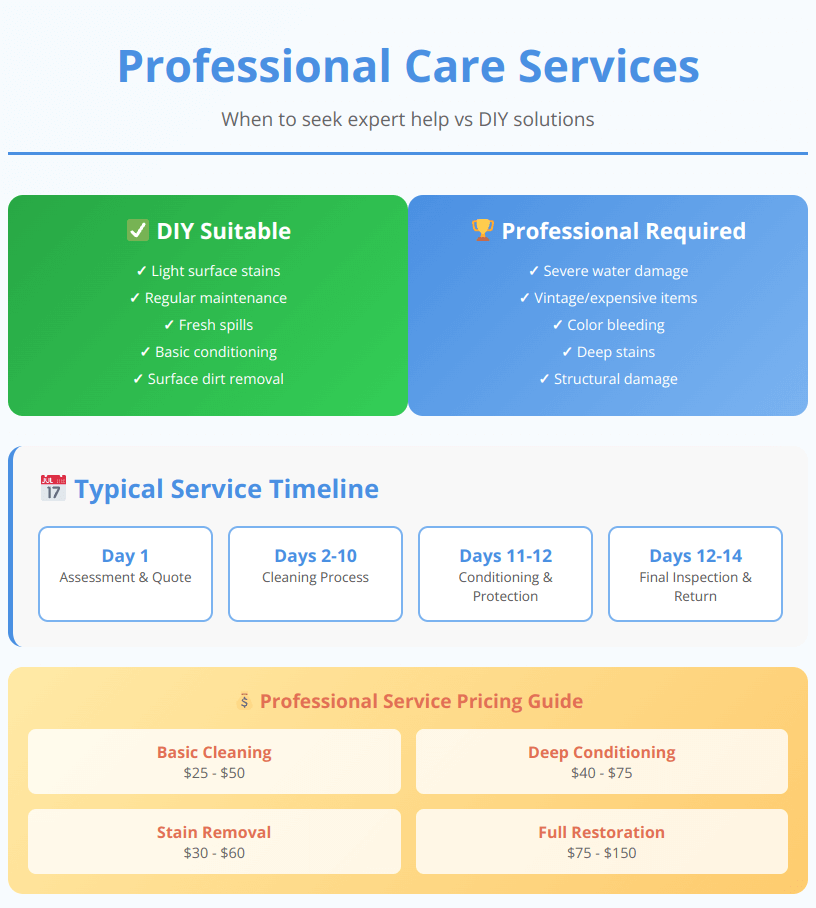
Professional restoration can often save severely damaged items, but success depends on acting quickly and choosing experienced specialists.
How to Restore a Suede Leather Jacket
Step-by-step restoration:
- Assessment – Identify damage type and severity
- Deep cleaning – Remove all dirt and stains
- Nap restoration – Use steam and brushing techniques
- Color treatment – Apply dyes if needed
- Protection – Apply appropriate protective products
- Professional consultation – For severe damage
Tools needed:
- Suede brush set
- Steam source
- Specialized cleaners
- Suede dyes (if needed)
- Protective sprays
Professional vs. DIY Restoration
DIY suitable for:
- Light staining
- Surface dirt
- Minor nap damage
- Regular maintenance
- Fresh spills
Professional required for:
- Severe water damage
- Color bleeding
- Structural damage
- Vintage or expensive items
- Multiple stain types
Professional leather conservation experts, as detailed in comprehensive guides from leather specialists, emphasize that museum-quality restoration techniques are essential for valuable vintage pieces. These methods include pH-balanced cleaners that match leather’s natural 4-5 pH level and specialized rehydration techniques for severely damaged items.
Cost Analysis and Investment Protection
ROI of Proper Leather Care
Cost comparison example:
- Quality leather jacket: $300-800
- Annual care supplies: $30-50
- Professional cleaning: $50-100/year
- Replacement cost without care: Every 2-3 years
- Lifespan with proper care: 10-20 years
Financial benefits:
- 5-10x longer item lifespan
- Maintained resale value
- Reduced replacement costs
- Professional appearance maintenance
Professional Service Costs
Typical pricing:
- Basic cleaning: $25-50
- Deep conditioning: $40-75
- Stain removal: $30-60
- Full restoration: $75-150
- Rush service: +50% surcharge
Value indicators:
- Experience with your leather type
- Specialized equipment and products
- Guarantee on work performed
- Reasonable turnaround time
Climate-Specific Care Guidelines
High Humidity Regions
Special considerations:
- Increased mold/mildew risk
- More frequent cleaning needed
- Better ventilation required
- Dehumidifier benefits
- Faster degradation potential
Care adjustments:
- Check items monthly for mold
- Use moisture-absorbing products
- Increase air circulation
- Consider professional storage
- Monitor closely in summer
Arid/Desert Climates
Challenges:
- Rapid moisture loss
- Increased cracking risk
- UV damage potential
- Dust infiltration
- Temperature extremes
Care modifications:
- More frequent conditioning
- Enhanced UV protection
- Regular cleaning routine
- Climate-controlled storage
- Professional assessment annually
Adapt your care routine to your specific climate challenges:

Climate-adapted care prevents 80% of environment-related leather damage and significantly extends item lifespan in challenging conditions.
Coastal Areas
Salt air concerns:
- Accelerated corrosion
- Staining potential
- Humidity fluctuations
- Enhanced cleaning needs
- Protective measures essential
Protective strategies:
- Weekly cleaning routine
- Monthly conditioning
- High-quality protectors
- Indoor storage preferred
- Professional maintenance quarterly
See the compelling financial case for investing in proper leather care:

The math is clear: proper care costs 60-70% less than frequent replacements while maintaining significantly higher resale value.
Expert Tips and Professional Insights
Industry Professional Recommendations
From master leather craftsmen:
- “Quality over quantity in products”
- “Consistency beats intensity in care”
- “Prevention is always cheaper than restoration”
- “Know your leather type before treating”
- “Professional consultation saves money long-term”
From luxury brand care specialists:
- Start care routine immediately upon purchase
- Document care history for warranty purposes
- Use brand-recommended products when available
- Schedule annual professional assessments
- Invest in proper storage solutions
Advanced Techniques from Professionals
Steaming technique:
- Hold 6-8 inches from steam source
- Work in small sections
- Brush while slightly warm
- Allow complete drying
- Repeat if necessary
Color restoration method:
- Match dye carefully to original color
- Test in hidden area extensively
- Apply in thin, even coats
- Allow full curing between coats
- Seal with appropriate protector
Learn from the professionals with these insider tips and advanced techniques:

These professional insights represent decades of combined experience and can help you achieve museum-quality results while avoiding common pitfalls.
Comprehensive FAQ Section
General Care Questions
How do you care for suede leather?
Regular brushing with a suede brush, immediate stain treatment, proper storage in breathable bags, seasonal protective spraying, and professional cleaning when needed.
How to maintain suede clothes?
Brush after each wear, store properly on padded hangers, treat stains immediately, apply protector sprays seasonally, and avoid wearing in wet conditions.
Can you wash suede leather with water?
Never wash suede with water. It will cause permanent damage including staining, texture loss, and structural problems. Use dry cleaning methods only.
How to protect suede fabric?
Apply specialized suede protector sprays before first wear and reapply every 3-4 months. Store in breathable containers away from moisture and direct sunlight.
Is suede ruined if it gets wet?
Not necessarily, but immediate action is required. Blot excess water, stuff with newspaper, air dry completely, then steam and brush to restore texture.
Does a suede protector work?
Yes, quality suede protectors create an invisible barrier against water and stains. They can prevent up to 80% of common damage when properly applied.
Product-Specific Questions
Should I spray my suede jacket?
Yes, apply a high-quality suede protector spray before first wear and reapply every few months. This prevents most water and stain damage.
What is the best suede protector?
Top choices include Saphir Super Invulner, Crep Protect, and Jason Markk Repel. Choose based on your specific needs and climate conditions.
Is vaseline good for leather?
No, petroleum jelly clogs leather pores and attracts dirt. Use proper leather conditioners designed specifically for the material.
Is WD-40 good for leather?
No, WD-40 is designed for metal and can damage leather. Use leather-specific conditioners and cleaners only.
Is olive oil good for leather?
No, olive oil can go rancid, darken leather, and attract dirt. Use commercial leather conditioners for best results.
Can you use baby oil on leather?
No, baby oil is too light and may cause staining. It doesn’t provide the proper conditioning that leather needs.
Storage and Longevity Questions
How long does a suede leather jacket last?
With proper care, a quality suede jacket can last 10-20 years. Factors include original quality, care routine, and usage frequency.
How to protect a suede jacket?
Regular brushing, immediate stain treatment, proper storage, seasonal protector application, and professional cleaning when needed.
How long does suede leather last?
Quality suede can last 10-20+ years with proper care, while budget suede typically lasts 2-5 years depending on usage and maintenance.
Conclusion
Proper leather and suede care is both an art and a science that requires understanding your materials, using the right products, and maintaining consistent routines. The investment in quality care products and techniques pays dividends through extended garment life, maintained appearance, and preserved value.
Key Takeaways for Long-Term Success
- Immediate action principles: Address spills and stains immediately to prevent permanent damage. The first few minutes after exposure often determine whether damage becomes permanent or manageable.
- Prevention over restoration: Protecting your leather and suede items before problems occur is always more effective and less expensive than trying to restore damaged pieces. Regular maintenance prevents most serious issues.
- Know your materials: Understanding whether you have full-grain leather, top-grain, suede, or nubuck determines the appropriate care methods. Using the wrong products can cause irreversible damage.
- Quality tools and products matter: Investing in proper brushes, cleaners, and conditioners designed specifically for leather and suede ensures better results and prevents accidental damage from inappropriate products.
- Climate awareness: Adjust your care routine based on your environment. Hot, dry climates require more frequent conditioning, while humid areas need enhanced mold prevention measures.
- Professional partnership: Develop a relationship with a reputable leather care professional for annual maintenance and emergency restoration. Their expertise can save valuable pieces that might otherwise be lost.
Long-Term Investment Strategy
Think of leather and suede care as protecting a financial investment. A $500 leather jacket that receives proper care can last 15-20 years, making the cost per wear extremely reasonable. Factor in the annual care costs of $50-75, and you’re still saving hundreds compared to frequent replacements.
Quality leather and suede pieces also retain value better when properly maintained. Well-cared-for vintage leather can actually appreciate in value, while neglected pieces quickly become worthless.
Environmental and Ethical Considerations
Proper care extends the life of animal-derived products, making your consumption more sustainable. When leather and suede items last decades instead of years, you reduce overall demand and environmental impact.
Many modern care products now offer eco-friendly formulations that provide excellent protection without harmful chemicals. Look for biodegradable cleaners and conditioners made from natural ingredients.
Building Your Care Routine
Start with a basic kit including a suede brush, leather conditioner, cleaning cloths, and protector sprays. As you become more experienced, you can add specialized products for specific needs.
Create a seasonal care calendar marking when to condition, clean, and protect your items. Regular maintenance is easier and more effective than sporadic intensive care sessions.
Document your care history, especially for valuable pieces. This helps with warranty claims and ensures you don’t over-condition or under-maintain your items.
Final Recommendations
- For beginners: Start with quality basics and focus on prevention. Learn to brush suede properly and condition leather regularly before attempting advanced techniques.
- For experienced caregivers: Experiment with premium products and consider learning professional restoration techniques for severely damaged pieces.
- For collectors: Invest in professional-grade equipment and consider climate-controlled storage for valuable vintage pieces.
- For everyone: Remember that consistency beats intensity. Regular light maintenance prevents the need for expensive professional restoration.
The journey of leather and suede care rewards patience and attention to detail. Your investment in proper care techniques and quality products will be reflected in garments that age gracefully, develop beautiful patina, and serve you faithfully for decades to come.
Whether you’re caring for a treasured vintage jacket, everyday work boots, or a special occasion handbag, the principles remain the same: understand your materials, use appropriate products, maintain consistent routines, and seek professional help when needed. Your leather and suede pieces will reward this care with years of reliable service and timeless style.

